Summer driving season is upon us and gas prices are on the rise. The national average at the pump is approaching $3 per gallon.REF Because crude oil is the largest single component in the price of a gallon of gasoline, the supply of and demand for crude oil around the world affects prices in the United States. Increased demand due to strong economic growth and curtailed supply from the Organization of Petroleum Exporting Countries (OPEC) and its allies have increased gas prices in the U.S.
Domestic producers, on the other hand, have ramped up supply to meet domestic and global energy needs. Through innovative extraction processes, U.S. crude oil supplies surpassed 10 million barrels per day, breaking a record high from nearly 50 years ago.
Furthermore, Congress and the Trump Administration have taken productive steps for U.S. producers to capitalize on untapped onshore and offshore reserves. However, policymakers can do more to remove market distortions and empower the energy industry to respond to changing market conditions. Reducing permitting time frames for the extraction and transportation of crude oil and eliminating crony policies that drive up the cost of gasoline, such as the Renewable Fuel Standard (RFS) and the Jones Act, would help drivers every time they fill up their tank.
Which Factors Contribute to the Price of a Gallon of Gas?
The price of crude oil is the single largest factor in the price of regular retail gasoline. In 2017, crude prices made up 50 percent of the price of gas, with federal and state taxes (19 percent), distributing and marketing (17 percent), and refining (14 percent) accounting for the rest.REF Over the past decade crude oil accounted for 61 percent of the total cost of a gallon of gas.REF
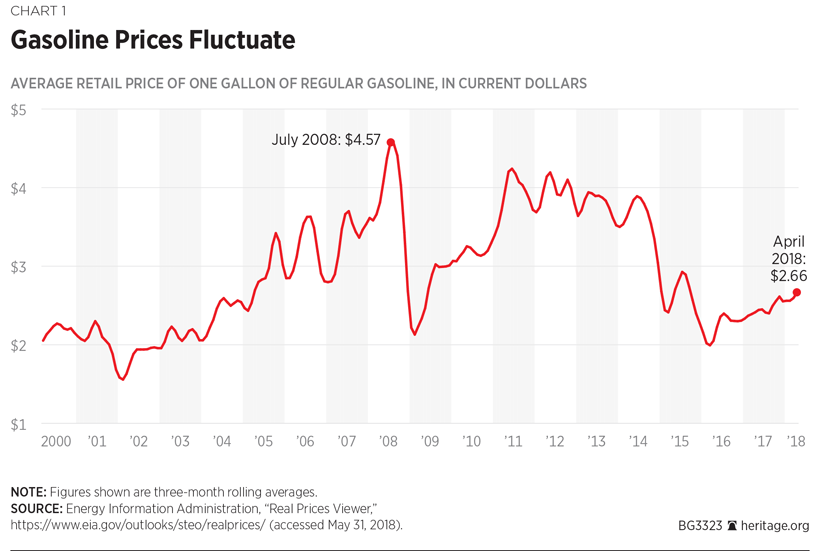
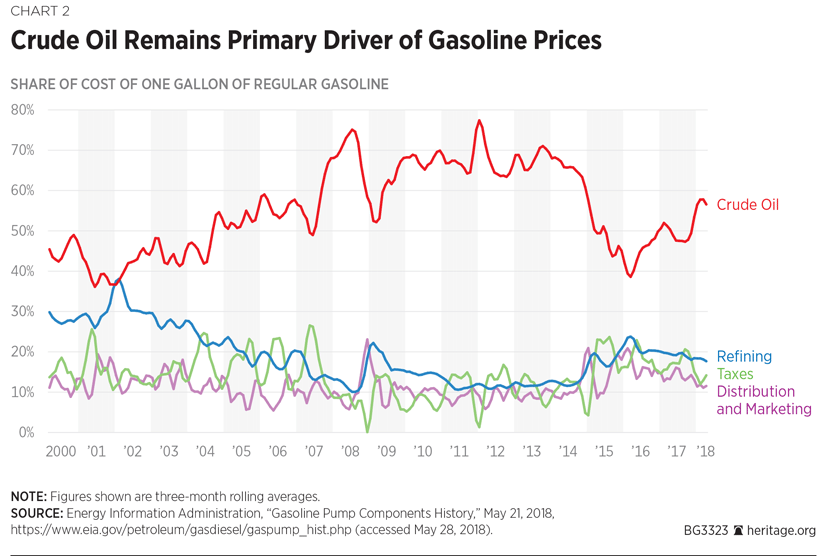
The federal excise tax on gasoline is 18.4 cents per gallon, and 24.4 cents per gallon on diesel fuel.REF States levy their own taxes and other fees, ranging from a low of 14.36 cents per gallon for gas in Alaska to more than 58.7 cents per gallon in Pennsylvania.REF The national average for state excises taxes and other state fees is 33.72 cents per gallon of gas.REF
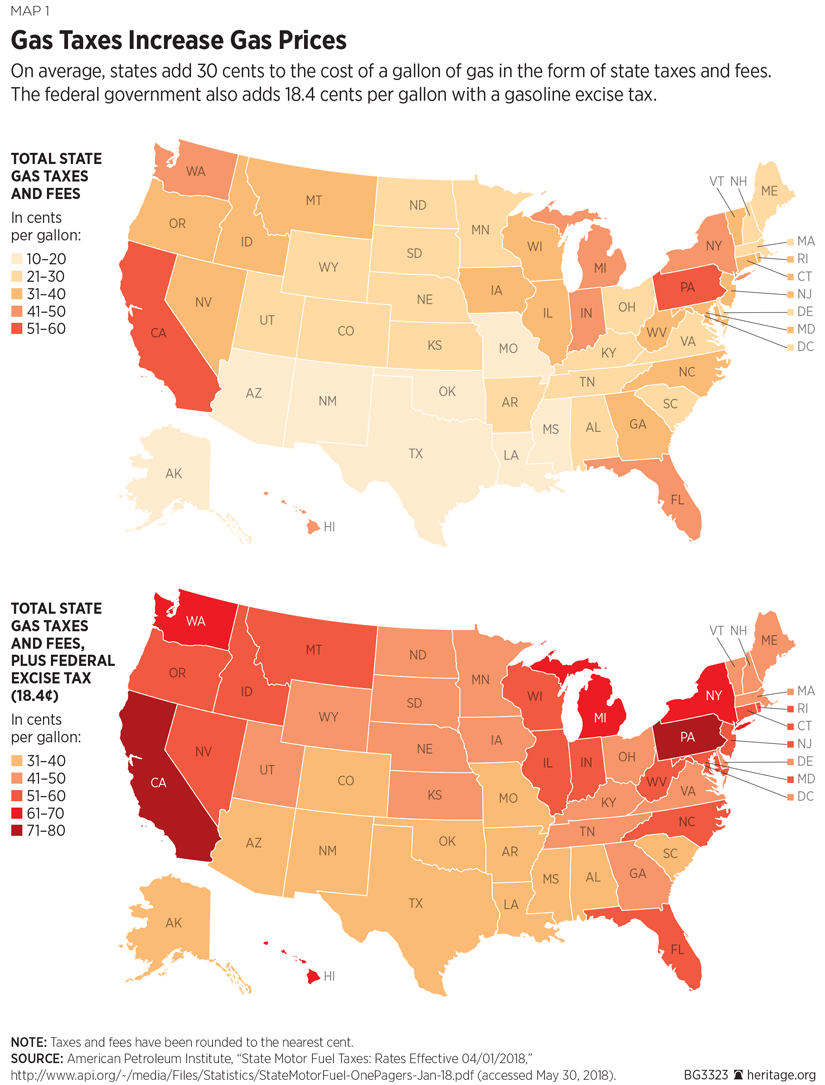
Because oil is a globally traded commodity, different factors around the world affect the supply of and demand for oil, in turn affecting the price Americans pay at the gas pump. Growing demand for oil in other parts of the world puts upward pressure on prices. Bad weather or geopolitical risks can disrupt supply. A hurricane can force a refinery to suspend operations, choking supply and driving prices higher.
Even the mere threat of such events can drive up prices because a potential supply disruption can affect oil futures markets. Speculators working in futures markets can increase the price of gasoline if inventories build up while sellers wait for higher prices, but that effect is marginal because companies must eventually offload those inventories. Global spare capacity also influences how rapidly and substantially prices change. The Energy Information Administration (EIA) defines spare capacity as the amount of oil that can be brought on the market within 30 days and sustained for 90 days.REF When oil markets are tight and have low spare capacity, the producers have less ability to respond by increasing supplies.
Global Events Affecting the Recent Increase in Gas Prices
Around the world, stronger demand for oil and curtailed supply has increased prices. According to the International Energy Agency (IEA), global oil demand increased 1.6 percent in 2017, significantly higher than the decadal average of 1 percent.REF The IEA cites robust demand in Asia, particularly China and India.
On the supply side, OPEC and friends of OPEC decided to cut back production at the end of 2016 and throughout 2017, in an effort to increase prices.REF With 2016 output levels as the baseline, 21 countries have been reducing production by a total of nearly 1.8 million barrels per day.REF Some countries, like Saudi Arabia, exceeded their production cuts while others produced more than they said they would. The collapse of the Venezuelan and Angolan economies resulted in substantial decreases in oil production and, consequently, OPEC is easily making its reduction targets.REF Additionally, the United States’ re-imposition of sanctions on Iran following the Trump Administration’s withdrawal from the Iran nuclear deal will curtail Iran’s production.REF
Over time, however, OPEC has been unable to restrict supplies and control oil prices because there are a diverse set of oil suppliers (both OPEC and non-OPEC), and its members have a strong incentive to cheat and increase oil production above their quotas. Even when oil prices were lower, some OPEC nations and OPEC allies failed to meet their reduction targets. If prices continue to increase and production continues to decline in Venezuela and Angola (and declines in Iran), the incentive to cheat, or to reverse the agreement, only grows stronger. In fact, Reuters reported that OPEC could agree to increase its production levels at its next official meeting in June.REF
What’s Happening in the United States?
As OPEC and its allies decided to cut production in 2017, producers in the U.S. increased output. The EIA recently reported that U.S. crude production surpassed 9.3 million barrels per day in 2017, a 5 percent increase over 2016 levels.REF In fact, in November 2017 the U.S. crude oil supplies surpassed 10 million barrels per day, breaking a record high from nearly 50 years ago. The extraordinary technological advancements in resource extraction have the United States in position to overtake Saudi Arabia and Russia as the world’s top oil producer. The latest projection from the EIA estimates that U.S. production could reach nearly 12 million barrels per day in 2019.REF
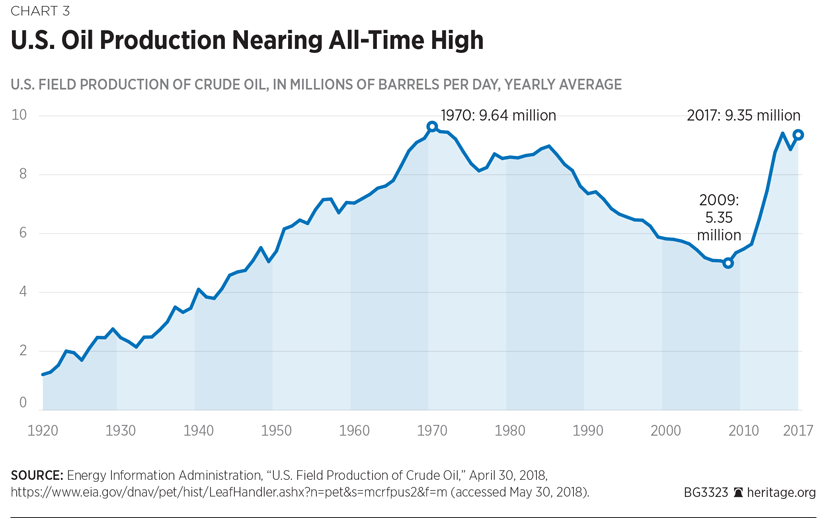
The Trump Administration is taking the necessary steps to open access to the abundance of resources under U.S. soil and off the coasts. Doing so will enable the energy industry to make near and long-term investments and respond more efficiently to changing prices. For instance, 94 percent of America’s offshore acreage—vast tracts thought to harbor nearly 100 billion barrels of oil—are off-limits to oil exploration. The Department of the Interior has drafted a proposal to open access to large swaths of these offshore resources, a move that would reverse a regulatory parting shot from the Obama Administration aimed at stifling natural resource extraction.REF
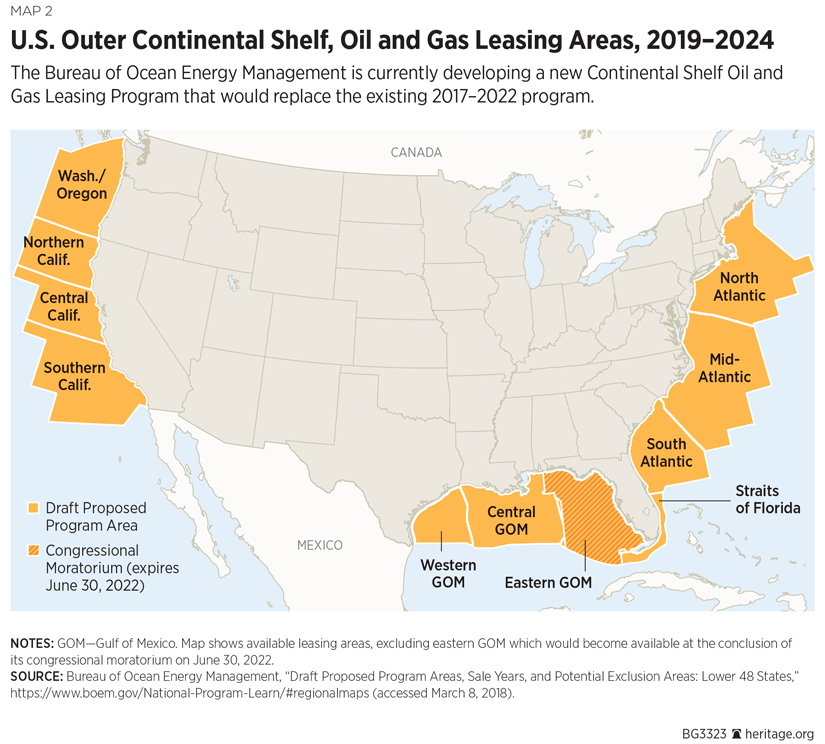
One of the many provisions in the Tax Cuts and Jobs Act is to require that the federal government hold lease sales in Alaska’s Arctic National Wildlife Refuge (ANWR), opening up the area to energy development. The energy potential of the area is enormous, with the U.S. Geological Survey estimating that ANWR contains 4.3 billion to 11.8 billion barrels of recoverable oil.REF Once companies drill exploratory wells, there will be a better sense of just how much oil ANWR holds. The amount of land available to energy production represents 0.01 percent of the refuge’s total land mass, and producers can access that oil with minimal environmental impact.REF
These policy actions may not have an impact on prices today; opening access now will ensure that businesses can be more responsive to changes in prices, rather than waiting for Congress to react after prices become politically uncomfortable. Energy policy should not be predicated on what analysts or Members of Congress think is going to happen, but rather on opening access and establishing the framework for competitive markets, while ensuring the protection of property rights and the environment.
Like in the rest of the world, stronger economic growth in the U.S. has also meant higher demand for oil. Particularly, the shale revolution and the availability of cheap oil and natural gas incentivized a large expansion of the petrochemical industry. Furthermore, the increased purchase of sport utility vehicles (SUVs) and trucks is increasing the demand for gasoline. According to the IEA, in the U.S. “the share of SUVs and light trucks increased from 47% in 2011 to around 60% of total sales in 2017, bringing up the share of these vehicles in the total passenger car fleet to almost half.”REF Additionally, the Obama Administration’s Environmental Protection Agency implemented Tier 3 gas regulations to lower the amount of sulfur in gasoline beginning in 2017. The increased stringency of the sulfur regulation in gasoline increases compliance costs for refineries, and hence for families and individuals, for negligible environmental benefit.
What Congress and the Administration Should Do to Help
High prices at the pump that are driven by market forces are not a compelling reason for the federal government to intervene in energy markets. Prices communicate information to energy producers, and they communicate information to energy users. Higher prices for oil incentivize companies to extract and supply more. Moreover, higher prices also incentivize entrepreneurs to invest in innovative alternatives to oil, whether batteries, natural gas vehicles, or biofuels. Drivers will examine their consumption options as well, whether carpooling, finding alternative modes of transportation, or, over time, purchasing a more fuel-efficient vehicle. Government intervention to address alleged price gouging will only harm American families and businesses.
Policymakers should examine government policies that artificially inflate gas prices. Congress and the Trump Administration should enact free-market reforms to relieve Americans’ economic pain at the pump. These include:
-
Delegate authority to states for environmental review and permitting of energy projects on federal lands within their borders. The Bureau of Land Management (BLM) estimates that it took an average of 227 days simply to complete a drill application—just one step in the approval process to harvest oil and gas resources on federal lands. It took 154 days in 2005.REF Although the current BLM is working to reduce that time frame, Congress should completely overhaul the process by delegating permitting authority to the states. When states oversee the process, regulators generally approve permits in a few days or weeks.REF According to a working paper from Utah State University economist Eric C. Edwards,
Even though 99 percent of federal drilling permits are eventually approved, bureaucratic delay imposes costs through delay and dampening. Drilling response is slower, and thus wells on federal lands do not respond to high oil and gas prices as quickly as private lands. These delays also lead to lower overall price responses—fewer overall wells drilled in response to price increases. Our findings indicate that the potential for improving the responsiveness of federal lands to price signals could be achieved through a reduction in delay in the BLM permitting process.REF
Allowing states to regulate the energy resources on federal lands means more efficient and accountable management, and frees federal resources for more pressing issues.
-
Streamline energy infrastructure permitting. The federal government has used ever-expanding authority to implement stringent regulations with increasingly high compliance costs and diminishing marginal environmental returns. These environmental regulatory roadblocks impede infrastructure energy investment—from new drilling operations to the transportation and refining of oil. Reforming environmental regulations with a focus on transitioning authority to the states, creating market incentives, and removing costly, ineffective regulations will improve the environment at a lower cost. Congress needs to implement wholesale reforms to the Clean Air Act, the Endangered Species Act, the “social cost of carbon” measurement, the National Environmental Policy Act, and use of nuisance litigation through citizen suit provisions in many of the major environmental laws.REF
-
Repeal the RFS. More commonly known as the ethanol mandate, the RFS mandates that refineries blend increasing amounts of ethanol into gasoline each year, reaching 36 billion gallons in 2022. During times of high gas prices, ethanol may appear to be less expensive, but after adjusting for the difference in energy content, higher concentrations of ethanol fuels are still more expensive.REF More choice and competition in the transportation fuels market can benefit consumers. However, when Congress forces “choice” on drivers through mandates and subsidies, the policies do much more harm than good. Innovation should drive energy choice. Subjecting biofuels producers to market competition will force biofuel producers to lower costs and enable the most competitive elements of the biofuel industry to thrive in a free market.
-
Repeal the Jones Act. Signed into law almost a century ago, the Jones Act mandates that any goods shipped by water between two points in the United States must be transported on a U.S.-built, U.S.-flagged vessel with a crew that is at least 75 percent American. By preventing foreign competition, the Jones Act significantly increases domestic maritime shipping prices, driving up costs for American businesses and consumers. For example, “Valero Energy, the largest refiner in the U.S., reported it costs $5 to $6 to ship a barrel of oil from the U.S. Gulf Coast to a refiner on the East Coast. It costs $2 to send that same barrel to Canada, since it can travel on a foreign ship at a much lower rate.”REF The Jones Act creates an unnecessary and expensive hurdle for shipping crude oil from coast to coast and Congress should repeal it.
Artificially high gas prices hurt consumers not only at the pump but also by raising the cost of all goods and services that depend on transportation. Market decisions should be left to the private sector and determined by price signals, not the federal government. Congress should refrain from non-solutions that meddle in energy markets, and eliminate the government-imposed barriers and policies that raise prices.
—Nicolas D. Loris is Research Manager for Energy and Environment, and Herbert and Joyce Morgan Research Fellow in the Thomas A. Roe Institute for Economic Policy Studies, of the Institute for Economic Freedom, at The Heritage Foundation.



